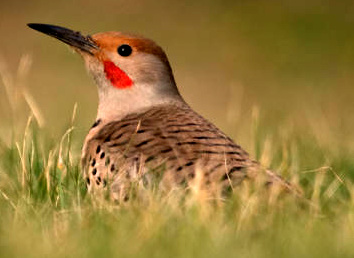
TRICKY!
When I was a child on a farm in Kentucky, my grandfather taught me that a certain woodpecker's name was Yellowhammer. Years later, when a newly published field guide was consulted, no Yellowhammer was mentioned. In that field guide, our Yellowhammer was identified as the Yellow-shafted Flicker. Nowadays, many more years later, field guides call Yellow-shafted Flickers by the name of Northern Flicker.
 Northern Flicker, Colaptes auratus; image courtesy of Peter Pearsall, US Forestry & Wildlife Service
Northern Flicker, Colaptes auratus; image courtesy of Peter Pearsall, US Forestry & Wildlife ServiceBefore popular bird field guides standardized English names for most North American birds, many bird species were known by a number of "country names" or "common names," which often changed from region to region, from community to community, and sometimes even from family to family. For the Northern Flicker, 132 names have been recorded!
Even today many North Americans speak of spotting "yellow canaries," though no canaries are native to North America. These people regard all small, yellowish birds as "yellow canaries." In North America, over fifty species of small, yellowish birds scattered through several different bird families might be called "yellow canaries." Most "yellow canary" sightings are either one of several goldfinch species or any of the many species of wood-warbler.
 Lentinus crinitis mushrooms in Mississippi, with no commonly used English name
Lentinus crinitis mushrooms in Mississippi, with no commonly used English nameThat's the problem with "common names." It's great when a person enjoys birds or any other natural thing and makes an effort to remember any name at all. However, we backyard naturalists need names we can look up on the Internet or in books, to see what's interesting about the named thing. Also, most species, especially among insects and other invertebrates, fungi, mosses, lichens and the like, have no common name at all.
Happily, nearly all the species we're likely to notice in our neighborhoods bear scientific or technical names called binomials. An organism's binomial is recognized worldwide by people speaking all languages. The binomial for the Yellowhammer/Yellow-shafted Flicker/Northern Flicker is Colaptes auratus.
Unfortunately, even technical binomial names sometimes can be tricky, but that's discussed on our Scientific Names page.